The Surprising Connection Between Responsibility and Hard Work:
A Journey Toward Fulfillment

In contemporary society, responsibility and hard work often go hand-in-hand. But what is the underlying connection between these two concepts? How does one complement the other, and why is their marriage more significant than merely fulfilling an obligation? Let’s explore how responsibility and hard work intertwine to pave the way for personal growth, success, and the realization of dreams.
Responsibility: More Than an Obligation
Responsibility goes beyond fulfilling duties or adhering to societal expectations. It’s a deeply personal commitment to take charge of one’s life, to align actions with values, and to pursue goals with determination and integrity.
Theodore Roosevelt once said, “With self-discipline, most anything is possible.” This underscores the idea that responsibility requires an inner commitment that drives us to act diligently and purposefully.
Hard Work: The Fuel for Responsibility
Hard work is the energy that propels us toward achieving our responsibilities. It’s the time, effort, and perseverance needed to realize our goals and bring our visions to life. Hard work is not just about the grind; it’s about being engaged, persistent, and resilient in the face of challenges.
Thomas Edison aptly expressed, “Genius is 1% inspiration and 99% perspiration.” The idea here is that achieving anything meaningful requires consistent and determined effort.
Responsibility and Passion:
A Symbiotic Relationship
What makes hard work and responsibility so intertwined is the passion that fuels them. When we take responsibility for something we genuinely care about, the hard work becomes not just an effort but a joyful pursuit.
Whether it’s a career goal, personal development, or a creative project, aligning responsibility with our passions turns the journey into a fulfilling adventure.
Cultivating Habits:
Building Blocks of Success
Taking responsibility and committing to hard work also means cultivating habits that align with our goals. These habits act as the building blocks of success, allowing us to approach challenges with grace and to grow continually.
Aristotle wisely stated, “We are what we repeatedly do. Excellence, then, is not an act, but a habit.” By forming habits that reflect responsibility and hard work, we shape our character and our destiny.
Charles Duhigg, in his book “The Power of Habit,” outlines how habits can be understood and transformed through a three-step loop: cue, routine, and reward. Identifying the cue that triggers a habit, then consciously choosing a routine that aligns with our values, and finally reinforcing it with a positive reward helps in making desired changes.
In the context of responsibility, it’s essential to recognize the habits that either support or hinder our progress and act accordingly. Perhaps the cue is a sense of obligation towards a particular goal; the routine could be the diligent and consistent effort applied, and the reward could be the satisfaction and growth resulting from achieving milestones.
Understanding and harnessing this framework empowers us to create new habits that resonate with our objectives and values. By nurturing habits that embody hard work and align with our responsibilities, we are not just building a solid foundation for success but also paving a path towards a more intentional and fulfilling life.
Growth and Success:
The Fruits of the Journey
The combination of responsibility and hard work leads to personal growth and success. By taking charge of our lives and investing effort in our pursuits, we expand our horizons, develop new skills, and realize dreams that might have seemed unattainable.
Colin Powell said, “A dream doesn’t become reality through magic; it takes sweat, determination, and hard work.” This encapsulates the transformative power of responsibility and hard work, turning aspirations into tangible achievements.
Real-Life Applications
In Careers: Taking responsibility for career development and putting in hard work leads to professional growth, satisfaction, and success.
In Relationships: Being responsible for our actions and working hard to maintain and nurture relationships leads to deeper connections and trust.
In Personal Development: Taking personal responsibility for growth and working hard to achieve self-improvement leads to a more fulfilled and enriched life.
In Sports: The arena of sports offers a vivid illustration of how responsibility and hard work can lead to phenomenal success. Athletes demonstrate clearly that taking personal responsibility for one’s growth and putting in the necessary hard work can lead to mastery and achievement. It’s a testament to how individual commitment can translate into collective triumph.
One quintessential example of the symbiosis between responsibility and hard work is the story of basketball legend Kobe Bryant. Known for his relentless work ethic, Kobe would often arrive hours before practice and stay long after it was over. His commitment to constant improvement and taking personal responsibility for his game made him one of the most outstanding athletes of his generation. Kobe’s approach wasn’t merely about hard work; it was about aligning that work with a clear vision and a deep sense of responsibility to himself, his team, and the game of basketball.
Similarly, Michael Jordan, another basketball great, often attributed his success to the relentless pursuit of excellence. He believed in embracing failure as a pathway to growth, putting in the hard work and taking responsibility for each step of his journey. Jordan’s dedication and resolve inspire countless individuals to approach their passions and responsibilities with a similar mindset.
These examples emphasize that the combination of responsibility and hard work isn’t confined to any particular domain. It’s a universal principle that can be applied across various aspects of life, and when embraced wholeheartedly, it leads to growth, fulfillment, and the realization of dreams and potentials. Whether in our careers, relationships, personal development, or sports, the key lies in aligning our actions with our values and putting in the dedicated effort to make our goals a reality.
What drives Responsibility >> Success?
The connection between responsibility and hard work is profound and multi-dimensional. It’s not merely about fulfilling obligations but about embarking on a journey filled with discovery, growth, and fulfillment.
When we align our responsibilities with our passions, values, and goals, the hard work becomes not a burden but an exciting and purpose-driven pursuit. It’s a journey filled with challenges and triumphs, growth and fulfillment, and above all, the joy of realizing our dreams and potentials.
Responsibility and hard work are partners in the dance of life, leading us toward a path of success and self-actualization. Are you ready to embrace this partnership and set out on a journey towards your dreams? The path is open, and the adventure awaits.
Comments on Responsibility and/or Hard Work…
Please leave us a comment with your thoughts on this article. Did it help you? Was it missing something? Do you have a great story about how you applied the ideas of Responsibility and Hard Work? Let us know in the comments.
If you missed the first article in this series, The Power of Response-ability, check it out at this link. Coach Wheeler also talks about Responsibility vs. Blame in this article. If you enjoyed any of these articles, be sure to follow Coach Wheeler on Facebook so that you will be notified when the next post drops!

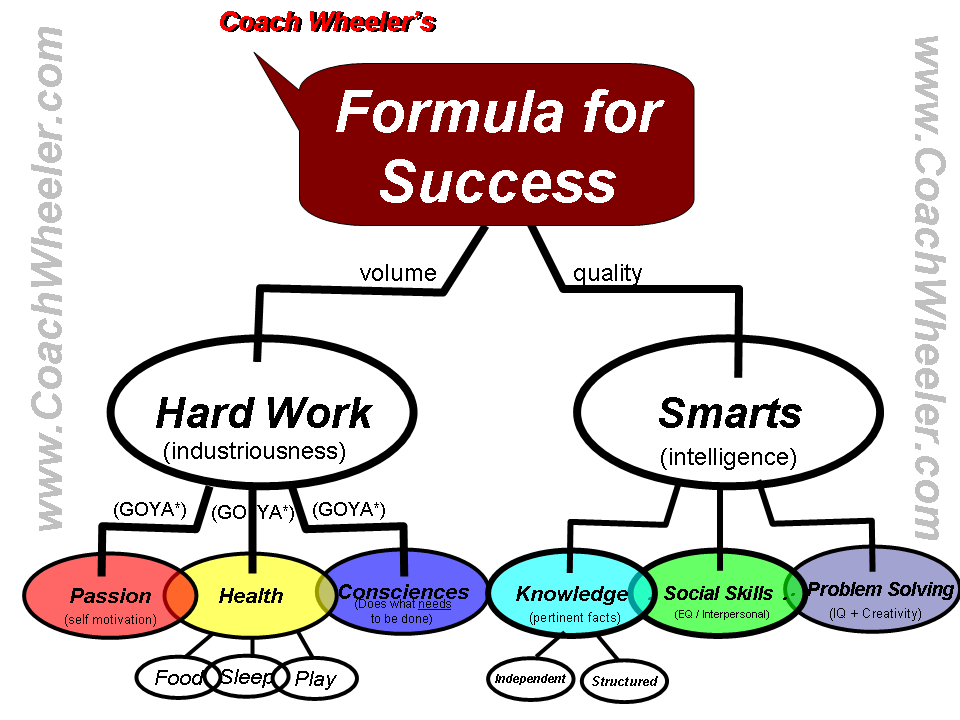
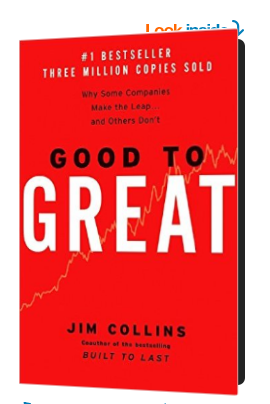

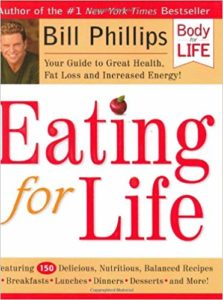
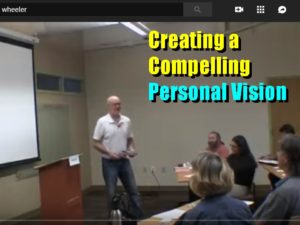
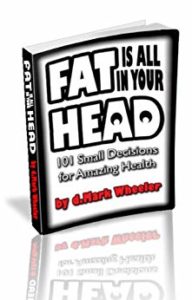
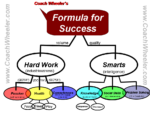
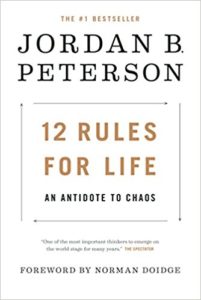
 This probably won’t sound earth shattering but it should make immediate sense when you think about it. “The
This probably won’t sound earth shattering but it should make immediate sense when you think about it. “The  The Formula for Success has 3 parameters under “Hard Work”. They are (1) Passion, (2) Health and (3) Consciences. Let’s look at each in more depth.
The Formula for Success has 3 parameters under “Hard Work”. They are (1) Passion, (2) Health and (3) Consciences. Let’s look at each in more depth.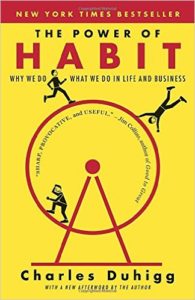
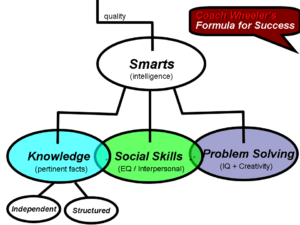 The second major component of Success is “Smarts” or “general intelligence”. Coach Wheeler breaks this down into 3 parts, (1) Knowledge, (2) Social Skills and (3) Problem Solving. Going back to Jordan B. Peterson, he has said that the studies show intelligence, as measured by IQ, is incredibly difficult to improve. On the other hand, Knowledge can continually be accumulated and you can gather facts or ideas that you can use across a wide variety of situations. Coach Wheeler also added Social Skills to his model for success and we will discuss how to build and leverage them more below.
The second major component of Success is “Smarts” or “general intelligence”. Coach Wheeler breaks this down into 3 parts, (1) Knowledge, (2) Social Skills and (3) Problem Solving. Going back to Jordan B. Peterson, he has said that the studies show intelligence, as measured by IQ, is incredibly difficult to improve. On the other hand, Knowledge can continually be accumulated and you can gather facts or ideas that you can use across a wide variety of situations. Coach Wheeler also added Social Skills to his model for success and we will discuss how to build and leverage them more below.
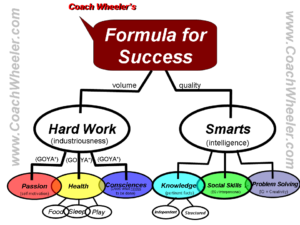
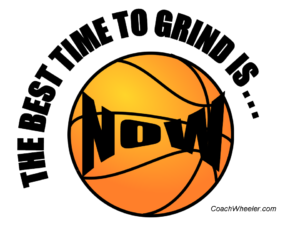 Summer is when you can make huge improvements as a basketball player… especially if you grind. GRINDing is all about
Summer is when you can make huge improvements as a basketball player… especially if you grind. GRINDing is all about 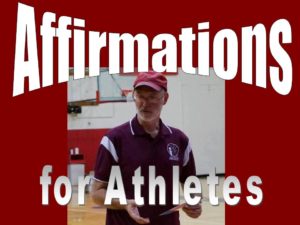 Affirmations are a powerful way for you, as an athlete, to overcome ways of thinking that are holding you back from becoming your best. Society has programmed many “limiting beliefs” into your mind over your lifetime. If you have read my post about
Affirmations are a powerful way for you, as an athlete, to overcome ways of thinking that are holding you back from becoming your best. Society has programmed many “limiting beliefs” into your mind over your lifetime. If you have read my post about 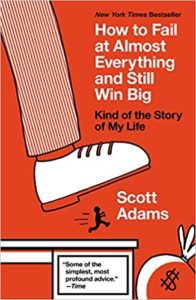
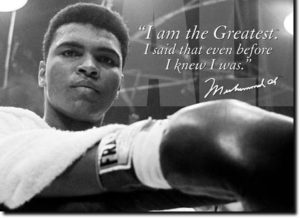
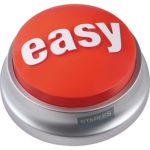

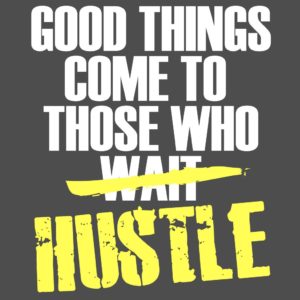 At the
At the 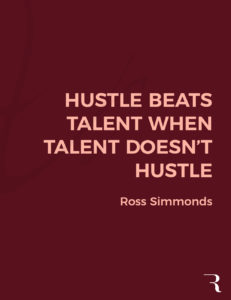 Why does Hustle matter?
Why does Hustle matter?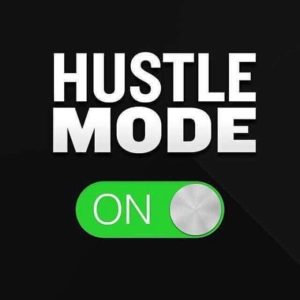 Want to improve your chances of making the team?
Want to improve your chances of making the team? What does it mean for a player to “take their game to the next level”? It sounds like a good thing but without understanding the meaning it is hard to get there, right?
What does it mean for a player to “take their game to the next level”? It sounds like a good thing but without understanding the meaning it is hard to get there, right? I coached this player as part of an AAU team when he was a freshman and he was a pretty good shooter. I won’t “name names” since I don’t want to embarrass him. Plus the advice could apply to a number of players.
I coached this player as part of an AAU team when he was a freshman and he was a pretty good shooter. I won’t “name names” since I don’t want to embarrass him. Plus the advice could apply to a number of players.